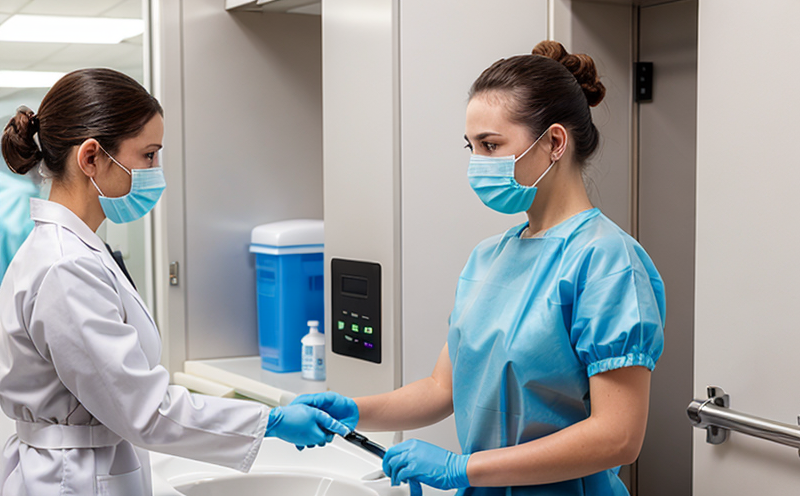Hygiene testing of textiles exposed to humid environments
The hygiene testing of textiles exposed to humid environments is a critical service that ensures the effectiveness and safety of products used in settings where microbial growth can pose significant health risks. This service encompasses a range of tests designed to evaluate the antimicrobial performance of textiles under conditions that mimic real-world usage, particularly in healthcare facilities, commercial buildings, and residential spaces.
Textiles exposed to humid environments are susceptible to bacterial, fungal, and mold contamination, which can lead to respiratory issues and other health problems. Hygiene testing focuses on the ability of antimicrobial textiles to inhibit or eliminate these pathogens when subjected to moisture and temperature conditions that promote microbial growth. The tests simulate actual usage scenarios, such as hospital gowns worn in intensive care units (ICUs) or bedding used by patients with compromised immune systems.
The primary objective of this service is to provide reliable data that helps manufacturers ensure their products meet stringent hygiene standards and are safe for end-users. This involves rigorous testing protocols that include both laboratory simulations and real-world applications, ensuring the accuracy and applicability of the results.
Key aspects of this service include:
- Test Parameters: Tests are conducted under controlled conditions to replicate environmental factors such as temperature, humidity, and microbial exposure time. These parameters are crucial in determining the efficacy of antimicrobial treatments.
- Specimen Preparation: Specimens are prepared according to ISO standards, ensuring that they accurately represent the real-world applications of the textiles being tested.
- Instrumentation and Methods: Advanced laboratory equipment is used to monitor microbial growth and assess the performance of antimicrobial treatments. Techniques such as agar diffusion tests or in-vitro testing are employed to measure the effectiveness of treatments against specific pathogens.
The results of these tests provide valuable insights into the durability and reliability of antimicrobial textiles under humid conditions, enabling manufacturers to optimize their products for better performance and safety. This service is particularly important in industries where hygiene standards are paramount, such as healthcare, food processing, and hospitality.
Understanding the nuances of this testing ensures that quality managers, compliance officers, R&D engineers, and procurement teams can make informed decisions about product development, material selection, and supplier evaluation. By leveraging this service, businesses can enhance their reputation for delivering high-quality, hygienic products, thereby gaining a competitive edge in the market.
Benefits
The benefits of hygiene testing of textiles exposed to humid environments extend beyond mere compliance with industry standards. This service provides numerous advantages that are vital for maintaining high levels of product quality and consumer trust:
- Enhanced Product Safety: By ensuring that textiles effectively resist microbial growth under humid conditions, this testing enhances the overall safety of products used in sensitive environments.
- Improved Brand Reputation: Demonstrating a commitment to hygiene and product quality can significantly enhance brand reputation, attracting more customers and fostering long-term customer loyalty.
- Regulatory Compliance: This service helps manufacturers meet regulatory requirements set by international standards such as ISO 20743 for antimicrobial textiles. Compliance with these standards is crucial for market access and legal adherence.
- Cost Savings: Early identification of potential issues through rigorous testing can prevent costly recalls and product failures, ultimately saving businesses time and resources.
In addition to these benefits, the service also facilitates continuous improvement in product design and manufacturing processes. By identifying areas for enhancement, manufacturers can refine their products to meet evolving market demands and customer expectations.
International Acceptance and Recognition
- ISO Standards: The International Organization for Standardization (ISO) has established several standards relevant to antimicrobial textiles, including ISO 18174-3:2006, which specifies methods for determining the efficacy of antimicrobial treatments. Compliance with these standards ensures that test results are internationally recognized and accepted.
- ASTM Standards: The American Society for Testing and Materials (ASTM) provides additional guidance through standards like ASTM E 2149, which covers the evaluation of microbiological activity in antimicrobial textiles. These standards are widely used across industries to ensure consistency and reliability.
By adhering to these international standards, manufacturers can ensure that their products meet global quality benchmarks, thereby facilitating easier market entry and broader customer acceptance. This service is particularly beneficial for businesses operating in multiple countries or seeking export opportunities.
Environmental and Sustainability Contributions
- Reduced Environmental Impact: By ensuring that textiles are effective against microbial growth, this service helps reduce the need for harsh chemicals and treatments to maintain hygiene. This contributes to a more sustainable approach in textile manufacturing.
- Eco-friendly Materials: The use of antimicrobial treatments can extend the lifecycle of textiles, reducing waste and promoting the use of eco-friendly materials that are less harmful to the environment.
The focus on sustainability is becoming increasingly important in the textile industry. By integrating hygiene testing into their processes, manufacturers can contribute positively to environmental conservation efforts, aligning with global trends towards more sustainable practices.





